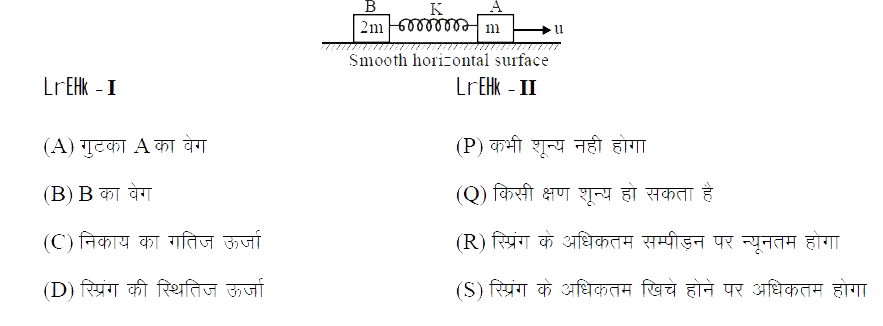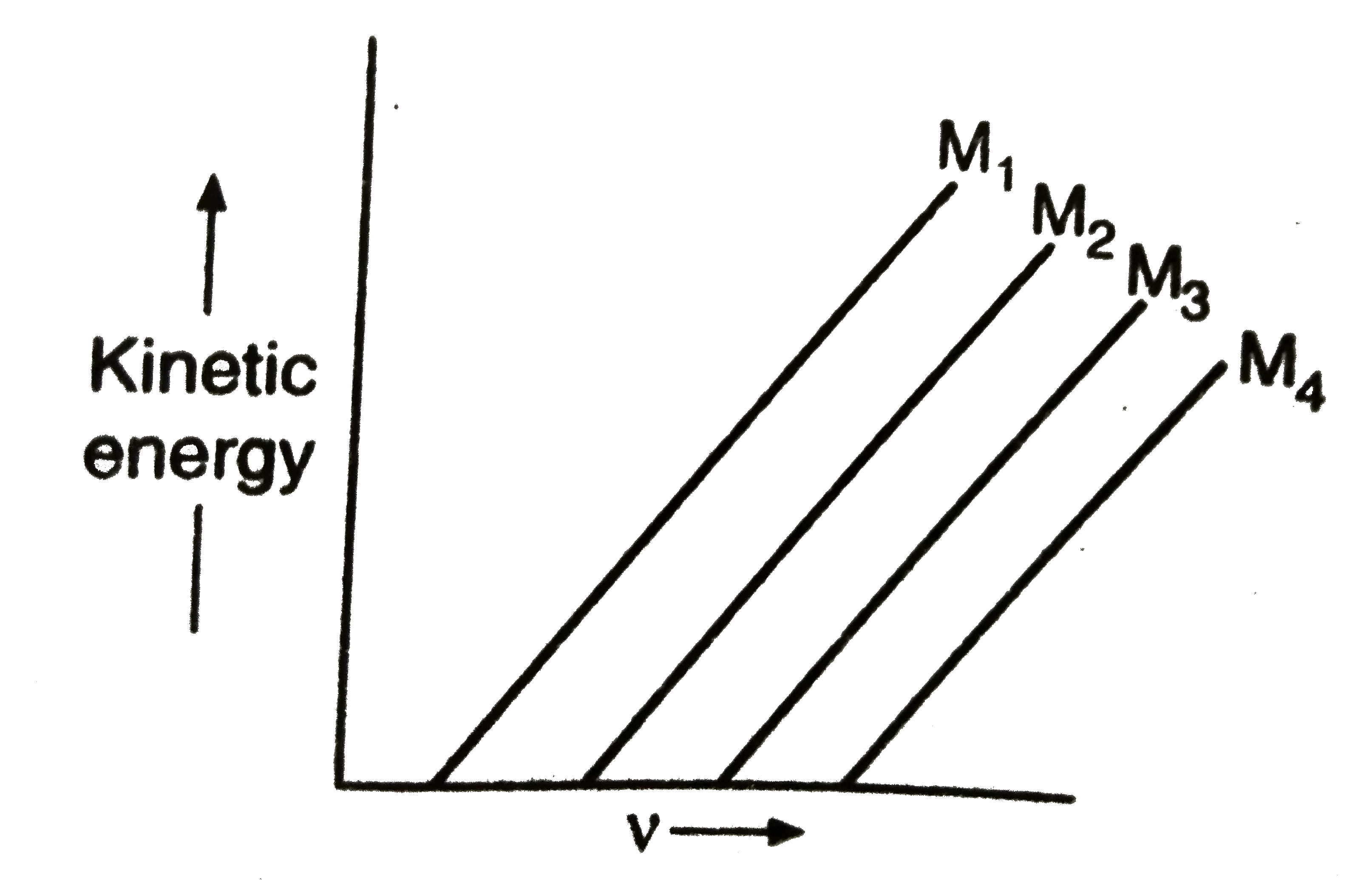द्रव्यमान m1 जब v वेग से तीनो समान द्रव्यमानो (m1=m2=m3=m) के केंद्र की दिशा में स्थित सरल रेखा की ओर क्षैतिज ऊर्जा गति कर रहा है तब टकराता है एवं m2 चिपक जाता है। प्रारम्भ में द्रव्यमान m2 एवं m3 स्थिर है एवं m2 स्प्रिंग अविस्तारित है ज्ञात करो -
(a) टक्कर के तुरंत बाद m1,m2 एवं m3 के वेग
(b) m3 की अधिकतम गतिज ऊर्जा
(c) m3 की अधिकतम ऊर्जा
स्प्रिंग के अधितकं संपीड़न

(a)v/2,v/2,0,(b)2mv2/9,(c)mv2/72,(d)x=√m/6kv
Topper's Solved these Questions
- BOOK - BANSAL HINDICHAPTER - MOMENTUM AND COLLISIONEXERCISE - Exercise -3 (JEE Main Previous Year.s Questions)13videos
MOMENTUM AND COLLISION
- BOOK - BANSAL HINDICHAPTER - MOMENTUM AND COLLISIONEXERCISE - Exercise - 4 (JEE ADVANCED Previous Year.s Questions)14videos
MOMENTUM AND COLLISION
- BOOK - BANSAL HINDICHAPTER - MOMENTUM AND COLLISIONEXERCISE - Exercise -1 (Objective Questions) Matrix Type1videos
MOMENTUM AND COLLISION
- BOOK - BANSAL HINDICHAPTER - MECHANICAL WAVESEXERCISE - EXERCISE-5 (Potential Problems Based on CBSE)13videos
MECHANICAL WAVES
- BOOK - BANSAL HINDICHAPTER - ROTATIONAL MECHANICSEXERCISE - EXERCISE - 5 (POTENTIAL PROBLEMS BASED ON CBSE)13videos
ROTATIONAL MECHANICS
Similar Questions
m1 व m2 द्रव्यमान के कणों के द्वि-कण निकाय पर विचार कीजिए। यदि प्रथम कण को द्रव्यमान केंद्र की ओर d दुरी तक धकेला जाता है, तो द्रव्यमान केंद्र को समान स्थिति पर रखते हुए द्वितीय कण को कितनी दुरी तक गति करनी चाहिए :
03:57View Solutionदो गेंदे जिनका रैखिक संवेग →p1=pˆi तथा →p2=−pˆi है, मुक्त आकाश में टकराती है। गेंदों के ऊपर कोई बाहरी बल नहीं है। टकराने के बाद उनका वेग संवेग →p'1 तथा →p'2 है। p,a1,a2,b1,b2,c1 तथा c2 के कंही भी शून्यतर मान के लिए निम्न में से जो अनुमत नहीं है (हैं), उनको चुने
03:42View Solutionदो गुटको A और B को एक आदर्श स्प्रिंग जिसका बल नियतांक क है जोड़कर क्षैतिज घर्षण रहित तल पर रखा गया है। क्षण t = 0 पर गुटके A का वेग u दायीं तरफ है जबकि B का वेग शून्य और स्प्रिंग अपने वास्तविक लम्बाई में है -
 02:44View Solution
02:44View Solutionध्वनि व प्रकाश तरंगों के बीच अन्तर के अनिवार्य बिन्दु क्या है ?
View Solutionएक बैलेट डांसर धीमा होने के लिये अपने हाथों को बाहर की ओर फैला लेती है। क्यों ?
View SolutionThe lines y=m1x,y=m2xandy=m3x make equal intercepts on the line x+y=1. Then (a) 2(1+m1)(1+m3)=(1+m2)(2+m1+m3) (b)(1+m1)(1+m3)=(1+m2)(1+m1+m3) (c)(1+m1)(1+m2)=(1+m3)(2+m1+m3) (d)2(1+m1)(1+m3)=(1+m2)(1+m1+m3)
03:38View SolutionIf (m_i,1/m_i),i=1,2,3,4 are concyclic points then the value of m1m2m3m4 is
04:00View SolutionIf (mi,1mi),i=1,2,3,4 are concyclic points, then the value of m1m2m3m4 is
02:53View SolutionMass m1 hits & sticks with m2 while sliding horizontally with velocity v along the common line of centres of the three equal masses (m1=m2=m3=m). Initially masses m2 and m3 are stationary and the spring is unstretched. Find
(a) the velocities of m1,m2 and m3 immediately after impact.
(b) the maximum kinetic energy of m3.
(c) the minimum kinetic energy of m2.
(d) the maximum compression of the spring.
 07:40View Solution
07:40View SolutionA plot of the kinetic energy (12mv2) of ejected electrons as a function of the frequency (v) of incident radiation for four alkali metals (M1,M2,M3,M4) is given below:

The alkali metals M1,M2,M3,M4 are respectively:03:12View Solutionसूत्र (m1x2+m2x1m1+m2,m1y2+m2y1m1+m2) क्या कहलाता है ?
03:03View SolutionTwo masses m1 and m2(m2>m1) are hanging vertically over frictionless pulley. The acceleration of the two masses is :
 03:01View Solution
03:01View SolutionIf (m1,1/m1),i=1,2,3,4 are concyclic points, then the value of m1m2m3m4 is
03:11View SolutionIf m1,m2(m1>m2) are the slopes of the lines which make an angle of 30∘ with the line joining the points (1, 2) and (3, 4), then m1m2=
View SolutionConsider the case of two bodies of masses m_(1) and m_(2) which are connected by light inextensible string passing over a light smooth pulley as shown in the figure. The expression for acceleration of the system and tension of the string are expressed below under different situations: (i) when m_(1) gt m_(2) . In this case a=((m_(1)-m_(2))/(m_(1)+m_(2)))g and T=((2m_(1)m_(2))/(m_(1)+m_(2)))g (ii) when m_(2) gt m_(1) . In this case a=((m_(2)-m_(1))/(m_(1)+m_(2)))g and T=((2m_(1)m_(2))/(m_(1)+m_(2)))g (iii) When m_(1)=m_(2)=m . In this case a = 0, T = mg If m_(1)=10kg, m_(2)=6kg and g =10m//s^(2) then what is the acceleration of masses?
04:32View Solution

